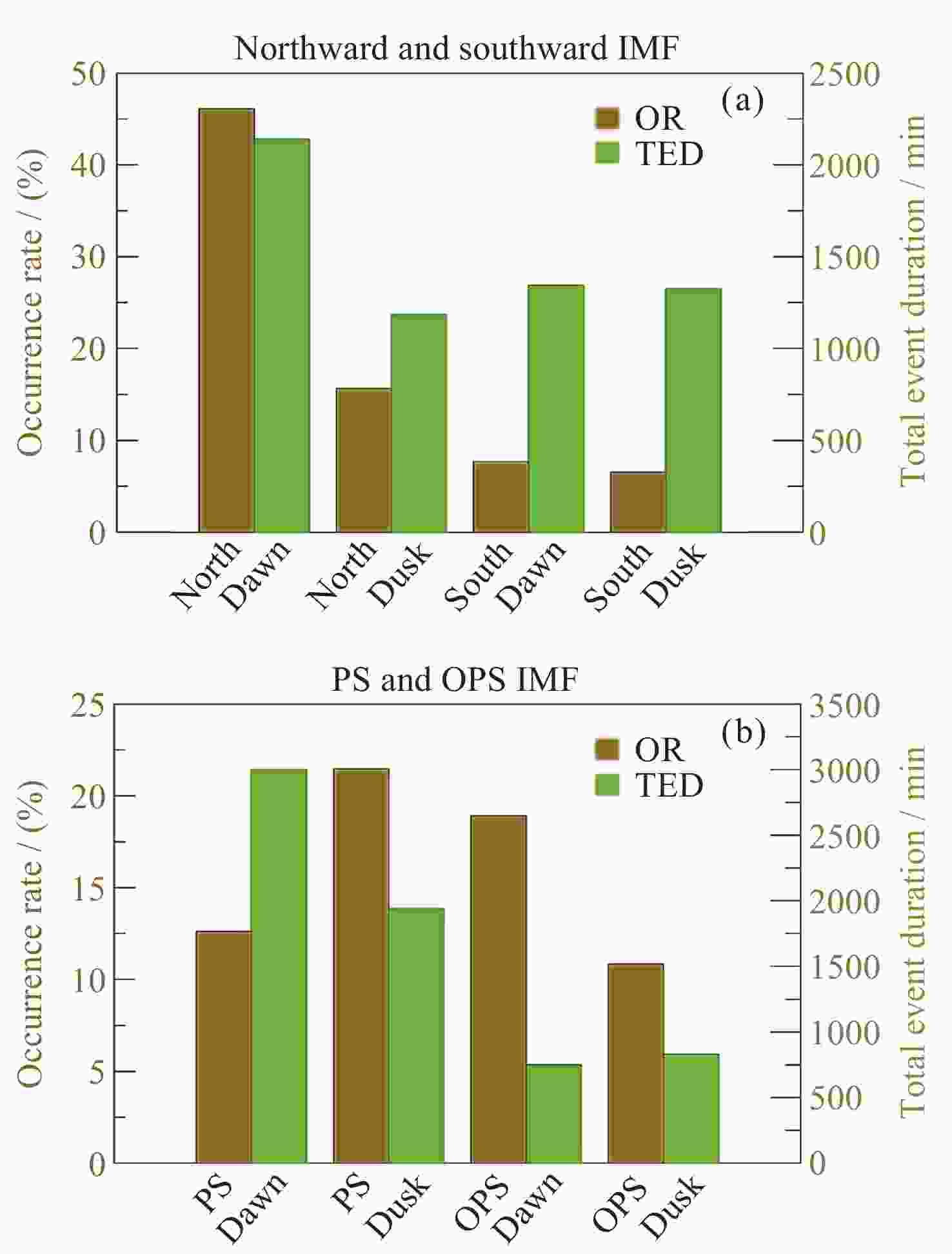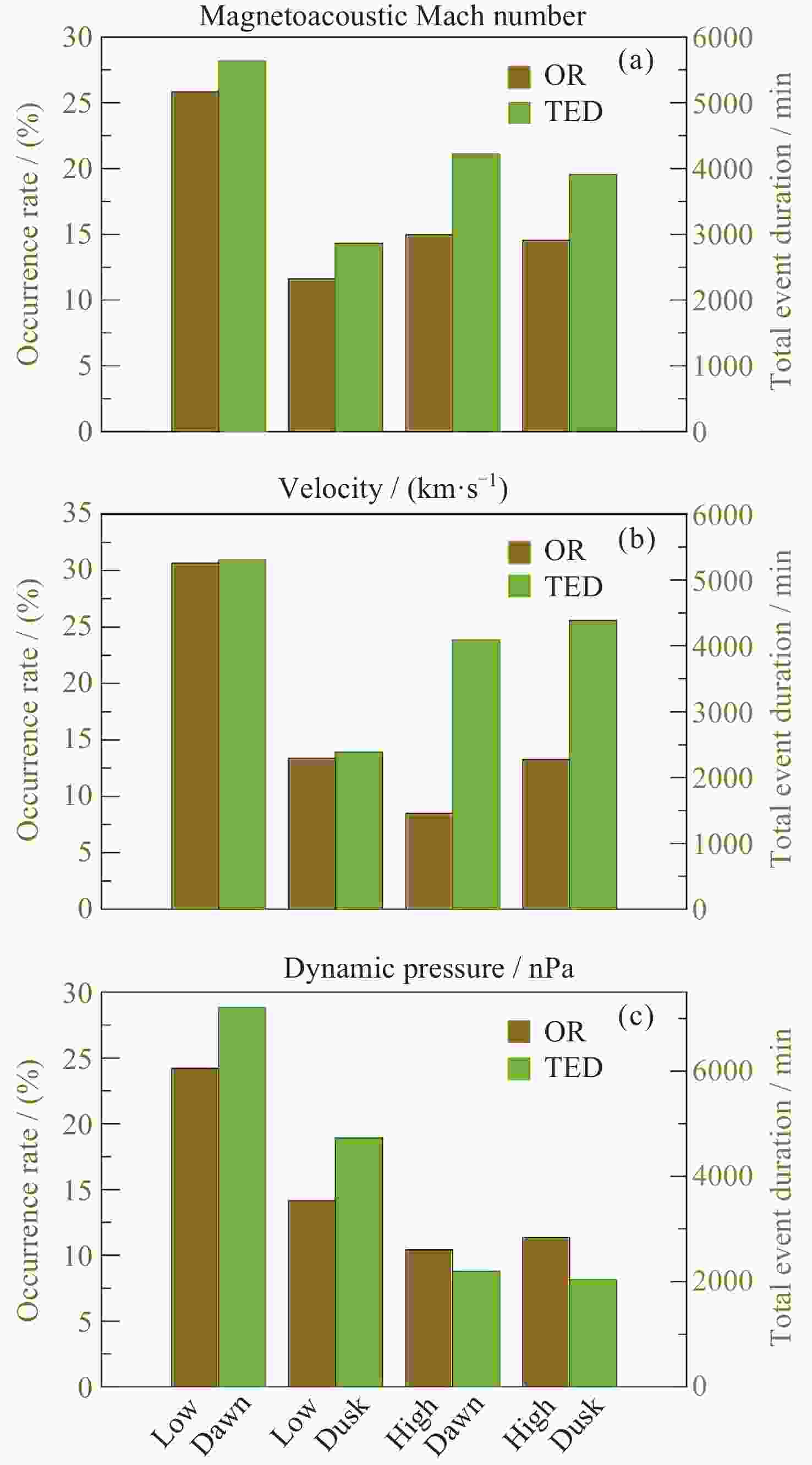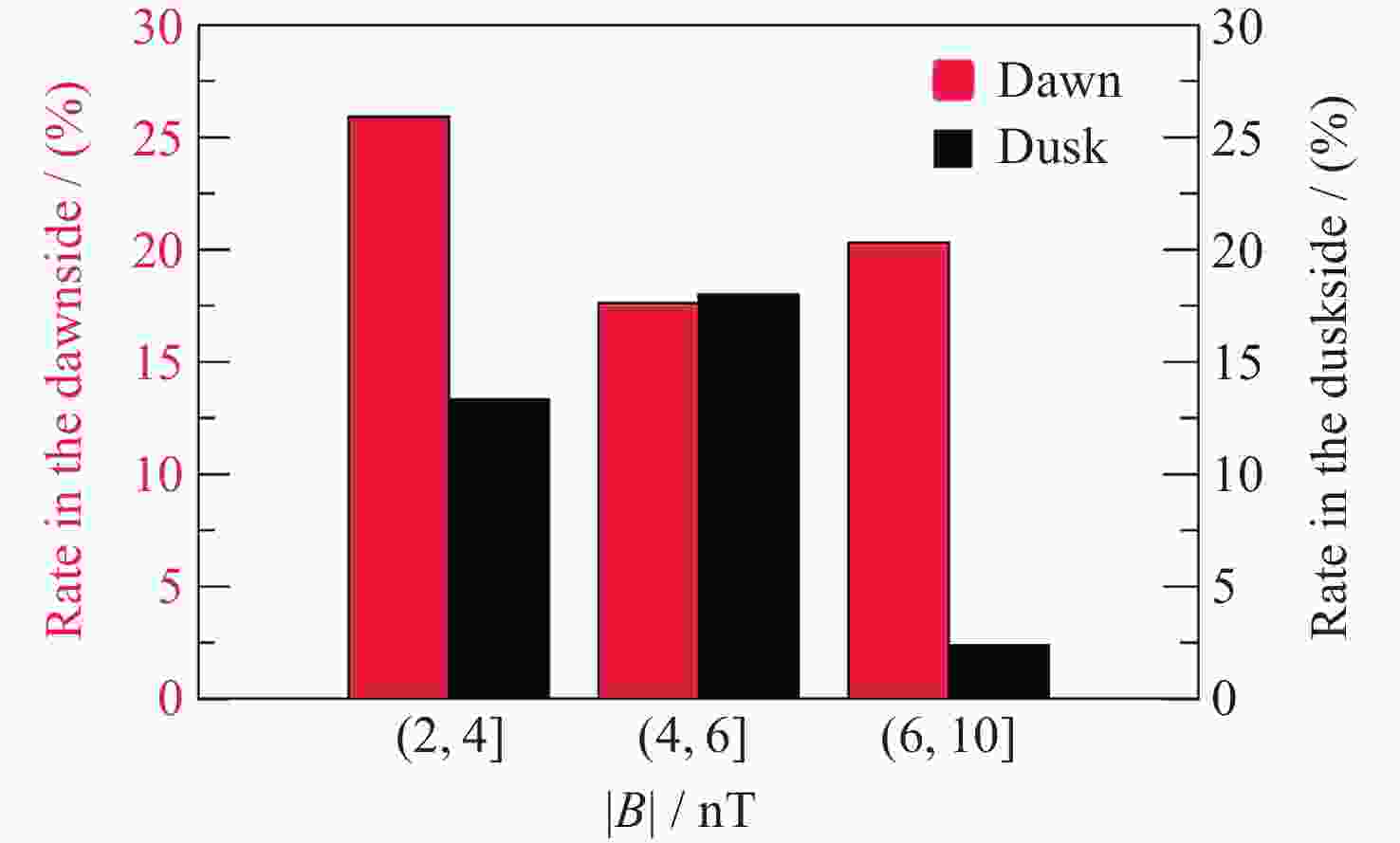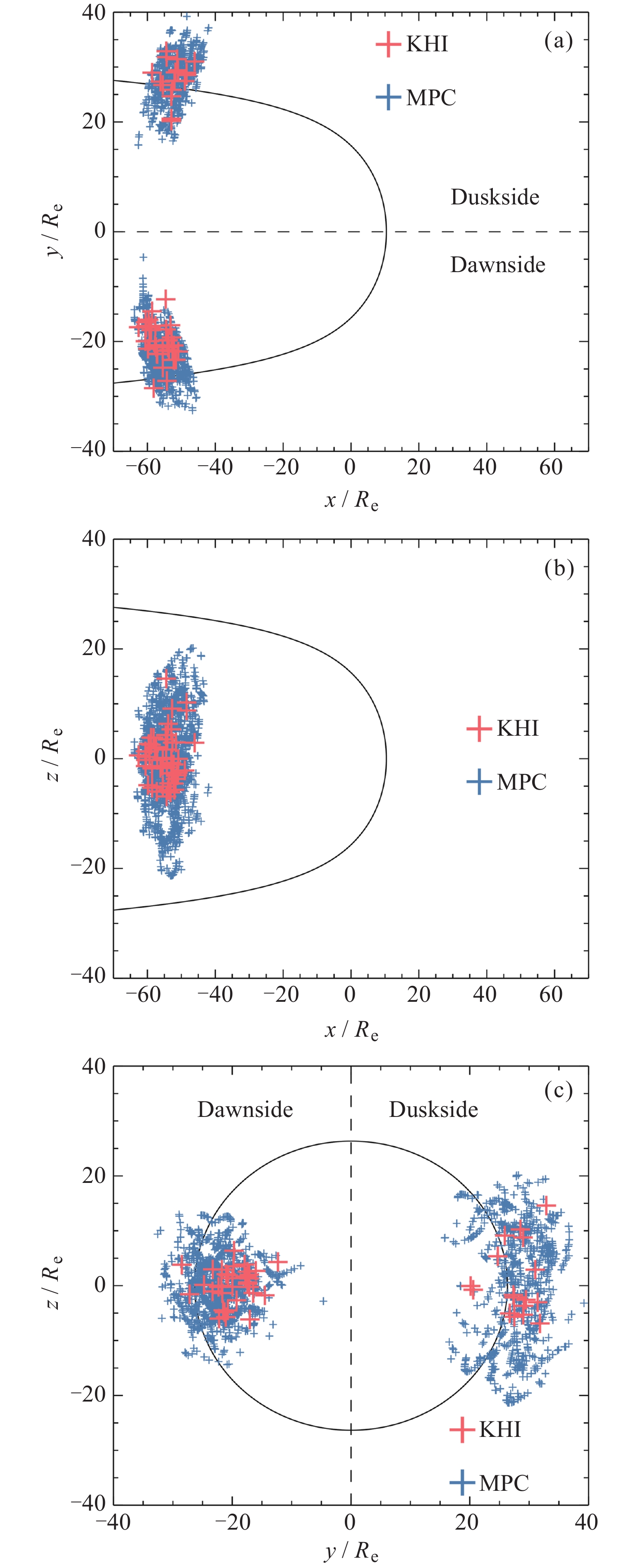Kelvin-Helmholtz不稳定性在中磁尾磁层顶的晨昏不对称性分布
doi: 10.11728/cjss2025.03.2024-0038 cstr: 32142.14.cjss.2024-0038
Dawn-dusk Asymmetry Distribution of Kelvin-Helmholtz Instability at the Magnetopause of the Mid-magnetotail
-
摘要: 地球磁层顶频发的开尔文–赫姆霍兹(Kelvin-Helmholtz, K-H)不稳定性在太阳风的物质和能量向地球磁层的输运过程中发挥着重要的作用. 研究筛选出2015-2020年中磁尾区域(X≈–60 Re)的磁层顶穿越事件, 结合51个中磁尾处的K-H不稳定性事件, 统计研究了K-H不稳定性在中磁尾磁层顶的晨昏不对称性分布. 结果表明, 在中磁尾区域, 磁层顶晨侧的K-H不稳定性发生率较高. 在行星际磁场(Interplanetary Magnetic Field, IMF)北向条件下, 发生在磁层顶晨侧的K-H不稳定性事件数量明显超越昏侧; 当帕克–螺旋(Parker-Spiral, PS) IMF主导时, 昏侧K-H不稳定性事件更多. 太阳风的不同参数也会显著影响中磁尾区域磁层顶晨昏两侧的K-H涡旋分布. 磁尾区域的K-H波动也是导致磁尾等离子体片中不同温度的等离子体分布不对称的原因之一.
-
关键词:
- Kelvin-Helmholtz不稳定性 /
- 晨昏不对称性 /
- 发生率 /
- 磁尾 /
- ARTEMIS卫星观测
Abstract: The Kelvin-Helmholtz (K-H) instability is an unstable phenomenon that occurs in the boundary layer between two different fluids with velocity shear, and plays an important role in particle, momentum, and energy transport from the solar wind to the magnetosphere. At the Earth’s magnetopause, the magnetosheath plasma flows rapidly along the magnetopause and creates a velocity shear with the stationary magnetospheric plasma, providing favorable conditions for the occurrence of the K-H instability. Our investigation selects the magnetopause crossings at the mid-magnetotail region (X ≈ –60 Re) from 2015 to 2020 using the observation data from the Acceleration, Reconnection, Turbulence, and Electrodynamics of the Moon’s Interaction with the Sun (ARTEMIS) satellite and, in conjunction with the 51 K-H instability events that also take place in the mid-magnetotail, conducts a statistical analysis of the dawn-dusk asymmetric distribution of K-H instability at the mid-magnetotail magnetopause. The findings suggest that the occurrence rate of K-H instability is relatively high on the dawn side of the magnetopause in the mid-magnetotail region. Under northward Interplanetary Magnetic Field (IMF) condition, the occurrence rate of the K-H instability events on the dawn side significantly surpasses that on the evening side; when the Parker-spiral IMF dominates, there are more K-H instability events on the duskside. The varying parameters of the solar wind also significantly influence the distribution of K-H vortices at dawnside and duskside of the mid-magnetotail magnetopause. Under conditions of low magnetoacoustic Mach number, the occurrence rate is higher on the dawnside. For slow solar winds, K-H vortices are significantly more frequent on the dawnside compared to the duskside. And the occurrence rate peak on the dawnside is pronounced under low dynamic pressure, while the occurrence rate at duskside is slightly higher than at dawnside for increased dynamic pressure. The K-H waves in the magnetotail region may contribute to the asymmetrical distribution of plasma in the magnetotail plasma sheet. -
图 1 2015-2020年由ATREMIS卫星观测到的中磁尾处所有磁层顶穿越事件和K-H不稳定性事件的分布 (磁层顶位形由文献[38]提出的磁层顶模型模拟得出)
Figure 1. Distribution of all Magnetopause crossing (MPC) events and K-H Instability (KHI) events observed by the ATREMIS satellite at the mid magnetotail from 2015 to 2020 (The shape of the magnetopause is given by the magnetopause model proposed by Ref. [38])
图 4 在不同的磁场强度区间内中磁尾磁层顶K-H不稳定性发生率在晨侧和昏侧的统计结果
Figure 4. Statistical results of the occurrence rate of K-H instability at the top of the magnetotail magnetosphere in different magnetic field intensity ranges on the morning and dusk sides. The gray and black bars represent the incidence of K-H instability on the morning and evening sides, respectively
表 1 行星际磁场方向分类标准
Table 1. Classification criteria for the IMF orientations
IMF类型 PS OPS NIMF SIMF 判定标准 Bx > 0.4Bt且By < –0.4Bt
或Bx < –0.4Bt且By > 0.4BtBx > 0.4Bt且By > 0.4Bt
或Bx < –0.4Bt且By < –0.4BtBz > 0.5Bt Bz < –0.5Bt 表 2 各种参数条件及不同数值区间内K-H不稳定性在中磁尾磁层顶晨侧和昏侧的发生率
Table 2. Incidence of K-H instability in the dawn and dusk sides of the mid-magnetotail magnetosphere under various parameter conditions and different numerical ranges
Parameter Range Rate on the dawnside/(%) Rate on the duskside/(%) IMF orientation Northward 46.12 15.64 Southward 7.67 6.50 PS 12.60 21.47 OPS 18.90 10.83 Magnetosonic Mach number 4< Mms ≤ 6 25.81 11.61 6< Mms ≤ 8 14.96 14.54 Magnetic field magnitude/nT 2< |B| ≤4 25.91 13.33 4< |B| ≤6 17.62 18 6< |B| ≤10 20.30 2.4 Velocity/(km·s–1) 200< |v| ≤400 30.64 13.37 400< |v| ≤800 8.46 13.26 Dynamic pressure/nPa 0< Pd ≤2 24.21 14.41 2< Pd ≤4 10.41 11.35 注 加黑数据为相同条件下较高的发生率. -
[1] MA X Y, OTTO A. Nonadiabatic heating in magnetic reconnection[J]. Journal of Geophysical Research: Space Physics, 2014, 119(7): 5575-5588 doi: 10.1002/2014JA019856 [2] COWEE M M, WINSKE D, GARY S P. Hybrid simulations of plasma transport by Kelvin-Helmholtz instability at the magnetopause: density variations and magnetic shear[J]. Journal of Geophysical Research: Space Physics, 2010, 115(A6): A06214 [3] MA X Y, OTTO A, DELAMERE P A. Interaction of magnetic reconnection and Kelvin-Helmholtz modes for large magnetic shear: 1. Kelvin-Helmholtz trigger[J]. Journal of Geophysical Research: Space Physics, 2014, 119(2): 781-797 doi: 10.1002/2013JA019224 [4] MATSUMOTO Y, HOSHINO M. Turbulent mixing and transport of collisionless plasmas across a stratified velocity shear layer[J]. Journal of Geophysical Research: Space Physics, 2006, 111(A5): A05213 [5] NAKAMURA T K M, HASEGAWA H, SHINOHARA I, et al. Evolution of an MHD-scale Kelvin-Helmholtz vortex accompanied by magnetic reconnection: two-dimensional particle simulations[J]. Journal of Geophysical Research: Space Physics, 2011, 116(A3): A03227 [6] OTTO A, FAIRFIELD D H. Kelvin-Helmholtz instability at the magnetotail boundary: MHD simulation and comparison with Geotail observations[J]. Journal of Geophysical Research: Space Physics, 2000, 105(A9): 21175-21190 doi: 10.1029/1999JA000312 [7] CHANDRASEKHAR S. Hydrodynamic and Hydromagnetic Stability[M]. Oxford: Clarendon Press, 1961 [8] DUNGEY J W. Electrodynamics of the Outer Atmosphere[C]//Physics of the Ionosphere. London: The Physical Society, 1955: 229 [9] FAIRFIELD D H, OTTO A, MUKAI T, et al. Geotail observations of the Kelvin-Helmholtz instability at the equatorial magnetotail boundary for parallel northward fields[J]. Journal of Geophysical Research: Space Physics, 2000, 105(A9): 21159-21173 doi: 10.1029/1999JA000316 [10] HASEGAWA H, FUJIMOTO M, PHAN T D, et al. Transport of solar wind into Earth’s magnetosphere through rolled-up Kelvin-Helmholtz vortices[J]. Nature, 2004, 430(7001): 755-758 doi: 10.1038/nature02799 [11] HWANG K J, KUZNETSOVA M M, SAHRAOUI F, et al. Kelvin-Helmholtz waves under southward interplanetary magnetic field[J]. Journal of Geophysical Research: Space Physics, 2011, 116(A8): A08210 [12] TAYLOR M G G T, LAVRAUD B, ESCOUBET C P, et al. The plasma sheet and boundary layers under northward IMF: a multi-point and multi-instrument perspective[J]. Advances in Space Research, 2008, 41(10): 1619-1629 doi: 10.1016/j.asr.2007.10.013 [13] LIN D, WANG C, LI W Y, et al. Properties of Kelvin-Helmholtz waves at the magnetopause under northward interplanetary magnetic field: statistical study[J]. Journal of Geophysical Research: Space Physics, 2014, 119(9): 7485-7494 doi: 10.1002/2014JA020379 [14] YAN G Q, MOZER F S, SHEN C, et al. Kelvin-Helmholtz vortices observed by THEMIS at the duskside of the magnetopause under southward interplanetary magnetic field[J]. Geophysical Research Letters, 2014, 41(13): 4427-4434 doi: 10.1002/2014GL060589 [15] LING Y M, SHI Q Q, SHEN X C, et al. Observations of Kelvin-Helmholtz waves in the Earth’s magnetotail near the lunar orbit[J]. Journal of Geophysical Research: Space Physics, 2018, 123(5): 3836-3847 doi: 10.1029/2018JA025183 [16] NAKAMURA T K M, BLASL K A, HASEGAWA H, et al. Multi-scale evolution of Kelvin–Helmholtz waves at the Earth's magnetopause during southward IMF periods[J]. Physics of Plasmas, 2022, 29(1): 012901 doi: 10.1063/5.0067391 [17] NAKAMURA T K M, BLASL K A, LIU Y H, et al. Diffusive plasma transport by the magnetopause Kelvin-Helmholtz instability during southward IMF[J]. Frontiers in Astronomy and Space Sciences, 2022, 8: 809045 doi: 10.3389/fspas.2021.809045 [18] HASEGAWA H, FUJIMOTO M, TAKAGI K, et al. Single-spacecraft detection of rolled-up Kelvin-Helmholtz vortices at the flank magnetopause[J]. Journal of Geophysical Research: Space Physics, 2006, 111(A9): A09203 [19] KAVOSI S, RAEDER J. Ubiquity of Kelvin-Helmholtz waves at Earth’s magnetopause[J]. Nature Communications, 2015, 6(1): 7019 doi: 10.1038/ncomms8019 [20] EASTWOOD J P, BALOGH A, DUNLOP M W, et al, Cluster observations of fast magnetosonic waves in the terrestrial foreshock[J]. Geophysical Research Letters, 2002, 29(22): 20246 [21] RUSSELL C T, PETRINEC S M, ZHANG T L, et al. The effect of foreshock on the motion of the dayside magnetopause[J]. Geophysical Research Letters, 1997, 24(12): 1439-1441 doi: 10.1029/97GL01408 [22] CHEN Q, OTTO A, LEE L C. Tearing instability, Kelvin-Helmholtz instability, and magnetic reconnection[J]. Journal of Geophysical Research: Space Physics, 1997, 102(A1): 151-161 doi: 10.1029/96JA03144 [23] NYKYRI K, OTTO A, LAVRAUD B, et al. Cluster observations of reconnection due to the Kelvin-Helmholtz instability at the dawn-side magnetospheric flank[J]. Annales Geophysicae, 2006, 24(10): 2619-2643 doi: 10.5194/angeo-24-2619-2006 [24] DIMMOCK A P, NYKYRI K. The statistical mapping of magnetosheath plasma properties based on THEMIS measurements in the magnetosheath interplanetary medium reference frame[J]. Journal of Geophysical Research: Space Physics, 2013, 118(8): 4963-4976 doi: 10.1002/jgra.50465 [25] NYKYRI K, OTTO A. Influence of the Hall term on KH instability and reconnection inside KH vortices[J]. Annales Geophysicae, 2004, 22(3): 935-949 doi: 10.5194/angeo-22-935-2004 [26] NYKYRI K. Impact of MHD shock physics on magnetosheath asymmetry and Kelvin-Helmholtz instability[J]. Journal of Geophysical Research: Space Physics, 2013, 118(8): 5068-5081 doi: 10.1002/jgra.50499 [27] HENRY Z W, NYKYRI K, MOORE T W, et al. On the dawn-dusk asymmetry of the Kelvin-Helmholtz instability between 2007 and 2013[J]. Journal of Geophysical Research: Space Physics, 2017, 122(12): 11888-11900 [28] DIMMOCK A P, NYKYRI K, KARIMABADI H, et al. A statistical study into the spatial distribution and dawn-dusk asymmetry of dayside magnetosheath ion temperatures as a function of upstream solar wind conditions[J]. Journal of Geophysical Research: Space Physics, 2015, 120(4): 2767-2782 doi: 10.1002/2014JA020734 [29] WANG C P, GKIOULIDOU M, LYONS L R, et al. Spatial distributions of the ion to electron temperature ratio in the magnetosheath and plasma sheet[J]. Journal of Geophysical Research: Space Physics, 2012, 117(A8): A08215 [30] HASEGAWA H, FUJIMOTO M, MAEZAWA K, et al. Geotail observations of the dayside outer boundary region: Interplanetary magnetic field control and dawn-dusk asymmetry[J]. Journal of Geophysical Research: Space Physics, 2003, 108(A4): 1163 [31] WING S, JOHNSON J R, NEWELL P T, et al. Dawn-dusk asymmetries, ion spectra, and sources in the northward interplanetary magnetic field plasma sheet[J]. Journal of Geophysical Research: Space Physics, 2005, 110(A8): A08205 [32] ZHOU Y, LU J Y, WANG M. Kelvin-Helmholtz waves on the magnetopause at the lunar distances under southward IMF: ARTEMIS observations[J]. Universe, 2022, 8(4): 209 doi: 10.3390/universe8040209 [33] ZHOU Y, SHUE J H, HASEGAWA H, et al. Spatial scales of the velocity shear layer and Kelvin-Helmholtz waves on the magnetopause: first statistical results[J]. Geophysical Research Letters, 2022, 49(4): e2021GL097271 doi: 10.1029/2021GL097271 [34] FARRELL W M, THOMPSON R F, LEPPING R P, et al. A method of calibrating magnetometers on a spinning spacecraft[J]. IEEE Transactions on Magnetics, 1995, 31(2): 966-972 doi: 10.1109/20.364770 [35] GLOECKLER G, BALSIGER H, BÜRGI A, et al. The solar WIND and suprathermal ion composition investigation on the WIND spacecraft[J]. Space Science Reviews, 1995, 71(1/4): 79-124 [36] MCCOMAS D J, BAME S J, BARKER P, et al. Solar wind electron proton alpha monitor (SWEPAM) for the advanced composition explorer[J]. Space Science Reviews, 1998, 86(1/4): 563-612 doi: 10.1023/A:1005040232597 [37] SMITH C W, L’HEUREUX J, NESS N F, et al. The ACE magnetic fields experiment[J]. Space Science Reviews, 1998, 86(1/4): 613-632 doi: 10.1023/A:1005092216668 [38] SHUE J H, CHAO J K, FU H C, et al. A new functional form to study the solar wind control of the magnetopause size and shape[J]. Journal of Geophysical Research: Space Physics, 1997, 102(A5): 9497-9511 doi: 10.1029/97JA00196 [39] MIURA A, PRITCHETT P L. Nonlocal stability analysis of the MHD Kelvin-Helmholtz instability in a compressible plasma[J]. Journal of Geophysical Research: Space Physics, 1982, 87(A9): 7431-7444 doi: 10.1029/JA087iA09p07431 -
-





 冯静伊 女, 2000年1月出生于河南省洛阳市, 南京信息工程大学大气物理学院空间天气研究所2021级硕士研究生, 主要研究方向为太阳风–磁层耦合. E-mail:
冯静伊 女, 2000年1月出生于河南省洛阳市, 南京信息工程大学大气物理学院空间天气研究所2021级硕士研究生, 主要研究方向为太阳风–磁层耦合. E-mail: 

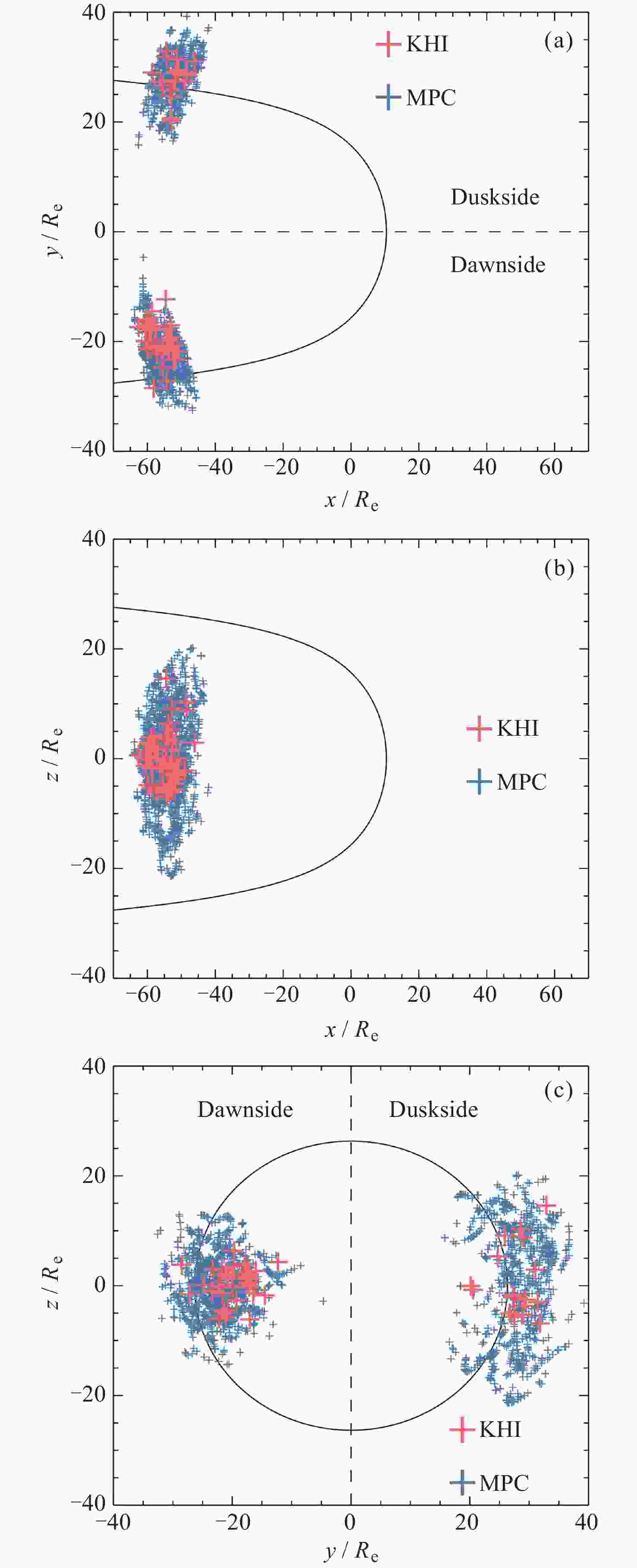
 下载:
下载:
